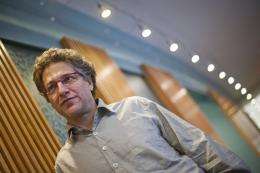Wasteland and wilderness

(PhysOrg.com) -- Harvard science historian and physicist Peter Galison is using part of his Radcliffe year to explore the intersections of forbidden wilderness and nuclear wasteland.
Ten thousand years from now, most of the radioactive waste from making nuclear weapons will still be dangerous. The half-life of plutonium, a key to fission bombs, is 24,000 years. Ten thousand years is equivalent to 400 generations of human life, a stretch of time as far ahead of us as the last Ice Age is behind us.
How do we communicate, so far into the future, the catastrophic danger of burial sites for nuclear waste? Current human languages may no longer be useful, and iconic images might actually attract future visitors, as the Great Pyramids do now, rather than warning of inherent danger, as would be their intent.
The puzzle of communicating with the future is part of what captivates science historian, physicist, and filmmaker Peter Galison, Harvard’s Pellegrino University Professor. He is using part of his year as a 2009-10 Radcliffe Fellow to research a feature documentary film on the world’s nuclear wastelands.
These vast zones of exclusion, he said in a Radcliffe lecture this week (Oct. 7), have generally been “a very small part of the history of science.” Instead, historians have preferred exploring bomb design and bomb making.
In turn, the nuclear-waste landscape — and its millennia of danger to mankind —have been relegated to “a relative blankness” of historical inquiry, said Galison, who himself shared in his discipline’s primary nuclear fascination. His first film, released in 2000, was “The Ultimate Weapon,” an exploration of the hydrogen bomb’s origins.
Galison also contends that America’s hundreds of nuclear wastelands — 3,000 square miles maintained by 100,000 people — share ironic legal and philosophical properties with wilderness areas.
Both kinds of places — “lands of purity and lands of defilement,” he called them — share a lexicon of exclusion. These exclusionary zones also suggest the possibility of a return to purity for nuclear wastelands, said Galison, “a fantasy of remediation” embraced by some federal authorities.
One official expressed this “metaphor of return” in terms of the face of a clock. The first six hours are already over — the bombs designed, made, tested, and stored. The last six hours are poised to move again, said Galison, “only this time, sweeping the land clean.”
But a countering metaphor is at work too for U.S. nuclear wastelands, he said, that they are, in the words of a Pentagon official, “national sacrifice zones.” Parts of Washington, Idaho, Florida, Georgia, Ohio, and New York may not be cleaned up at all, but may become monuments to the presumed necessity of nuclear weapons.
Over time, how will people cope with these vast forbidden areas? Galison said the reality of these dangerous places has already stretched the law to cover unprecedented periods of time — 10,000 years, according to one federal regulation.
Warning markers will be necessary, he said. Starting in the 1990s, federal authorities brought together eclectic gatherings of experts to puzzle out how to alert future generations: materials scientists, architects, designers, linguists, even science fiction writers.
But the challenge itself is not science fiction; the future is here. The Department of Energy’s Waste Isolation Pilot Plant near Carlsbad, N.M., opened in 1999 and is already half full. About 3 million cubic feet of transuranic radioactive waste is stored half a mile below the surface, said Galison, in disposal chambers carved out of a 250-million-year-old Permian salt formation.
Shapes might do the future job of warning, said Galison, who flashed designs onto a screen at Radcliffe Gymnasium: gigantic thorns, leaning spikes, massive earthworks, “forbidding blocks,” and leering, grimacing gargoyles.
Words might still work too. Federal authorities have considered putting warnings in all the official languages of the United Nations — plus Navaho.
To develop the right warnings, the Waste Isolation Pilot Plant has even funded speculative descriptions of future worlds. Scenarios include an eco-feminist world, set in 2091, in which all presumed masculine values are suspect; overweening religious powers convinced that the storage sites contain secret scrolls; or legions of humanoid robots digging into the buried waste.
But Galison is exploring more than wastelands for his future film. It will be about wildernesses too, which in some traditions share the same sense of being uncontrollable, taboo places. “I enter the swamp,” he quoted Henry David Thoreau, “as a sacred place.”
The Wilderness Act of 1964, said Galison, picked up on this theme of the forbidden, defining wilderness as a place “where man himself is a visitor who does not remain.”
And some proponents of Deep Ecology — a philosophical construct of the last 40 years — contend that “vast areas of whole continents should be off-limits” to humans, Galison said. There are “messages back and forth” between the idea of wasteland and the idea of wilderness. For one, an industry is emerging to make waste sites tourist destinations, attractive for the ecological purity that neglect has brought.
The Pacific’s Bikini Atoll, whose nearby seas are crowded with radioactive warships sunk in atomic bombs tests, is now “one of the top five dive destinations in the world,” said Galison.
The intersections of wilderness and wasteland have changed our sense of the natural world, making people feel something more complex than simply ownership or awe. Confronted with nature, he said, we are “neither biblical masters, nor romantic servants.”
Provided by Harvard University (news : web)













